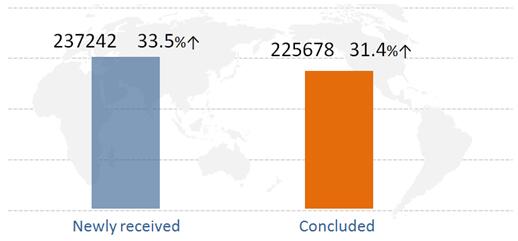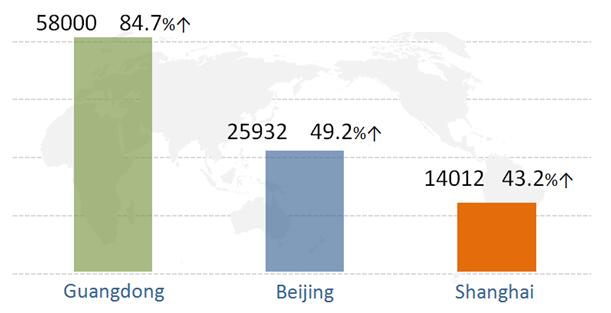
|
Author: CHEN,Sean |
|
Partner | Patent Attorney | Attorney at Law |
In the just past intellectual property (IP) awareness week1, the Supreme Court made a report on the judicial protection of intellectual property in China (2017)(hereinafter referred to as the Protection of intellectual property), introducing the latest development and protection of intellectual property in China from a national level, and an annual report on intellectual property cases (2017)(hereinafter referred to as the Case Report), introducing 42 legal application issues in 33 typical cases made by the Supreme Court in 2017. This paper provides interpretations of a part of the two reports, hoping to help readers better understand the current status of Chinese intellectual property judicial protection.
1. Substantial Increase in the numbers of IP Cases
According to the protection status report (as shown in Figure 1) in 2017, the total numbers of cases being newly received and concluded by the courts across the country are increased.

Figure 1. Newly received cases V. concluded cases in all China Courts in 2017 (including 1st instance, 2nd instance,application for retrial),and their increasing rate over 2016
With respect to civil First Instance Case of intellectual property, the number of copyright, trademark and patent cases were 137,267, 37,946 and 16,010 respectively, with an increase of 57.80%, 39.58% and 29.56% over 2016. With respect to the terrestrial distribution of the above IP cases, the number of cases received by courts in Beijing, Shanghai and Guangdong accounted for more than 50% of the overall number across the country, as shown in Figure 2.

Figure 2. Newly received 1st instance cases in Guangdong,Beijing and Shanghai in 2017,and their increasing rate over 2016
Comments: Protection of intellectual property is increasingly valued in China. Intellectual property judicial system have been greatly improved in trial period and the amount of damages, and the amount of intellectual property cases in China has increased significantly in the past year. In addition, the report pointed out that the courts in Beijing, Shanghai and Guangdong received the majority of the IP cases (accounting for more than 50% of the total number of the country). We believe that two reasons lead to such situation, the first is that Beijing, Shanghai and Guangdong have instituted specialized intellectual property courts and such courts are equipped with experienced trial teams for case hearing; and the second is that such courts are able to trial civil cases, administrative cases, and criminal cases so that the courts' judgment are better standardized. Moreover, from our experience, specialized intellectual property courts in Beijing, Shanghai and Guangdong tend to decide on higher damages, which is also a reason that the patentee favors these courts.
2. Reform of Judicial System
The protection status report pointed out that in 2017, the IP judicial system was further reformed, establishing three intellectual property courts in Beijing, Shanghai and Guangzhou, and also instituting intellectual property courtrooms with cross-regional jurisdictions in 15 cities such as Nanjing, Suzhou and Wuhan. The protection status report also pointed out that the research on the establishment of a national level appeal mechanism for intellectual property cases is under process.
Comments: From the first establishment of the Beijing Intellectual Property Court in 2014, after several years of endeavor, a total of eighteen IP courts/courtrooms have been established across the country with a jurisdiction of IP civil, administrative and criminal cases, such cases were previously governed by different courts (take Beijing as an example, such IP cases were previously governed by the first, second and third Intermediate people's Court). In another word, the reform of the IP judicial system at the first instance level has been generally completed (at present, IP appeal cases are still under the jurisdiction of various local high courts). The next step of the reform is to research on the establishment of the State Intellectual Property Court (similar to the Court of Appeals for the Federal Circuit, CAFC in the US), which is important to further unify trial standards.
3. Convenience to foreign entities
The Protection Status Report pointed out that approximately 20% of the IP cases involve foreign entities (one or both parties are foreign entities). Especially, in Beijing Intellectual Property Court, 30% of the IP cases are foreign-related cases. According to the report, the trial period of the foreign-related cases in China is fairly short. For example, the average trial period for foreign-related cases in the Beijing Intellectual Property Court is 4 months.
Comments: From our experience in practice, the trial period of the foreign-related cases, especially foreign-related civil cases, are indeed greatly shortened. Moreover, all parties are treated fairly equally during the trial of the foreign-related cases. We believe that a shorter trial period and improved efficiency of the procedure for foreign-related IP cases have been achieved.
4. Increase of penalties for IP infringements
The Judicial Protection Report pointed out that the protection of intellectual property rights has been fully strengthened in 2017. The Supreme Court emphasized that judicial work should be market-value orientated. That is to say, focus should be put on addressing the issue of low compensation for the IP infringement conducts, increasing the penalties of IP infringements, and increasing the illegal cost of the infringers.
Comments: From our experience, the average amount of compensation of patent infringement lawsuits increased significantly in the past few years. For example, the average amount of compensation decided by Beijing Intellectual Property Court was about 1.4 million (there were also some very high compensation records by different courts, such as 9.1 million (IWNComm V. Sony, Beijing IP Court), and 37.2 million (Goertek V. Knowles, Huaifang Intermediate Court)). We believe that the current trend of reform is to favor patentees and further increase damages. Specifically, measures such as increasing the upper limit of statutory damages for infringement as well as establishing a punitive damage system are all under consideration.
5. Landmark cases decided by the Supreme Court
This section listed the Supreme Court's latest findings regarding patent infringement in its case report, which provided significant guidance for future patent infringement cases.
With respect to interpretation of claims, the Supreme Court pointed out (Dyson Technology Co., Ltd. v. Suzhou Suvac Electric Motor Co., Ltd. , 2017 Supreme Court Min Shen No. 1461) that in determining the meaning of a terminology in a claim, where the same patent applicant or patentee has made a clear statement of the same terminology during the patent right authorization and affirmation procedure of other patents that have the same priority as the patent in dispute, such statement can be referenced and considered. Previously, there was controversy around whether reference could be made to a statement in another patent of the same family which share the same priority. Here, the Supreme Court made it clear that such statements could be referenced and considered.
With respect to restrictions on applying the promissory estoppel principle, the Supreme Court pointed out (Cao Guilan, Hu Meiling, Jiang Li, Jiang Haotian v. Chongqing Lifan Automobile Sales Co., Ltd., 2017, Supreme Court Min Shen No. 1826) that when the promissory estoppel principle is applied, to determine whether the statement made by the rights-holder complies with the "explicit negation" prescribed in Article 13 of Interpretation II2, one should focus on whether the rights-holder's statement of narrowing the technical solution is finally accepted, and whether such statement leads to a patent application being granted or patent rights being maintained.
With respect to the technical aspects of a decision on an infringement, the Supreme Court pointed out (Liu Zonggui V. Taizhou Fenglilai Plastics Co., Ltd., 2017, Supreme Court Min Shen No. 3802) that properly dividing the technical features of patent claims is the basis for comparison of infringement. The division of technical features should be considered combining with the overall technical solution of the invention. Relatively small technical units that can relatively independently achieve certain technical functions and produce relatively independent technical effects should be considered.
With respect to whether a claim is based on specifications, the Supreme Court pointed out (Sensing Electronics Co., Ltd. V. State Intellectual Property Office Patent Reexamination Board, 2016, Supreme Court Xing Zai No. 19) that when determining whether a claim is based on specifications, one can identify the technical problems to be solved and the technical effects to be achieved in conjunction with the specifications ("defects in prior arts", "objectives of invention", "technical problems to be solved", "beneficial effects", etc., described in the background, summary, and detailed description). The "technical problems to be actually solved" redefined according to the distinguishing technical features of the claims and the "closest prior art" should not be directly used as the basis for determining whether the claims are based on the specification.
With respect to online shopping jurisdiction, the Supreme People's Court pointed out (Guangdong MARTNIEL Clothing Co., Ltd., Zhou Lelun V. New Balance Trade (China) Co., Ltd., 2016, Supreme Court Min Xia Zhong No. 107) that in intellectual property rights infringement cases and unfair competition cases, where a plaintiff purchased an allegedly infringing product through online shopping, it is not appropriate to apply Article 203 of the Interpretation of the Supreme Court on the Application of the Civil Procedure Law of the People's Republic of China, which uses the place of receipt as the place where the infringement occurred to determine the territorial jurisdiction of the case.
With respect to the nature of a Markush claim, the Supreme Court pointed out (State Intellectual Property Office Patent Reexamination Board V. Beijing Wansheng Pharmaceutical Co., Ltd., Daiichi Sankyo Company Limited, 2016, Supreme Court Xing Zai No. 41) that when a claim is drafted as a Markush claim, such claim should be considered as a general claim that defines multiple alternative elements, rather than a collection of numerous compounds. The general rule of allowing amendments to a Markush claim is that the amendments should not result a class of compounds or a single compound that possess new property or effect. However, it should be considered on a case by case basis4.
6. Conclusion
Overall, China's intellectual property judicial system has been further improved, courts have been continuously increasing penalties for intellectual property infringements, and better judicial protection has been provided for intellectual property rights. This prompted intellectual property rights holders to take the initiative to file intellectual property cases. The increased number of intellectual property cases in 2017 proved this point. Moreover, the Supreme People's Court is considering setting up a national intellectual property court, increasing statutory compensation, and introducing punitive damage to further strengthen judicial protection of intellectual property rights.
1 The IP Awareness Week is from April 20 to April 26 each year, of which April 26 is the Intellectual Property Protection Day
2 Article 13 of Interpretation II of the Supreme People's Court on Several Issues Concerning the Application of Law in the Trial of Cases Involving Patent Infringement Disputes: Where the right holder proves that the narrowed revision or statement made by the patent applicant or the patentee in respect of the claims of rights, written descriptions and attached drawings in the patent licensing affirmation procedure was negated, the competent people's court shall determine that such revision or statement does not lead to the waiver of the technical solution
3 Article 20 of the Judicial Interpretation of Civil Procedure Law of the People's Republic of China: For a sales contract concluded on an information network, if the subject matter is delivered on the information network, the place of domicile of the buyer shall be the place where the contract is performed; or if the subject matter is delivered by any other means, the place of receipt shall be the place where the contract is performed, unless the parties have agreed otherwise on the place of performance in the contract.
4 For details, please refer to "Amending a Markush claim in an invalidation procedure became more difficult" in the newsletter.



